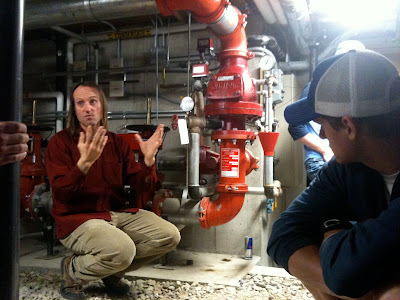SD Spotlight: Shane Scranton
Shane shares his thoughts on today’s fieldtrip…

“On Thursday April 8th the Solar Decathlon class traveled to the Marsh-Billings-Rockefeller National Historic Park in Woodstock, VT. Steve was the head architect of a LEED Platinum certified building in the park, the Forest Center, and we spent the afternoon exploring this energy efficient building that, conveniently, shared many characteristics with our envisioned Solar Decathlon house. Steve designed this building to fit the Park. All of the wood comes directly from the managed land, and since the Forest Center is made almost entirely of wood it truly exemplifies building with local materials. The building is pushed to one side of a field, creating an open corridor which points to an old storage facility that currently houses a ton of wood and a historical exhibit on the second floor. These buildings communicate with the pristine Vermont landscape surrounding them and they create an image not unlike the write-up found on the homepage of the National Park Service’s website:
'Walk through one of Vermont's most beautiful landscapes, under the shade of sugar maples and 400-year-old hemlocks, across covered bridges and alongside rambling stone walls. This is a landscape of loss, recovery, and conservation. This is a story of stewardship, of people taking care of places - sharing an enduring connection to land and a sense of hope for the future.'

Steve’s Forest Center has a connection to the land, and this is an impressive architectural feat that we should all keep in mind as we move forward with the schematics for our own house. We want our New England Farmhouse to connect to nature, and by using the Forest Center as a precedent we are closer to achieving this goal.

Inside the Building… Entering the Forest Center, the first thing that struck me was the smell. A comfortable, earthy, wood smell that made almost everyone in our group smile. The tall gabled roof gave the areas in the building a spacious and warm feel. Once inside we were all drawn towards the interior walls, which, made out of different kinds of local wood, had their common and scientific names engraved into them. There was plenty of well placed glazing that allowed for an abundant amount of natural light, and the result of the wood, light, and high ceilings was an enjoyable, comfortable, and bright space. The classroom / assembly room is the primary room in this building, and centered above it is a small monitor that allows for more light infiltration and air circulation.

Upon entering the Forest Center, the first thing that we noticed was the smell, a comfortable, earthy, wood smell that made everyone in the group smile. The tall gabled roof gave the open areas of the building a spacious and warm feel. Once inside, we were drawn to the interior walls, which were made of numerous species of local wood. There were plenty of windows that provided abundant natural light, and the result of the wood, light, and high ceilings was an enjoyable, comfortable, and bright space. The assembly room is the primary room in this building, and centered above it is a small monitor that increases natural light and air circulation."
















